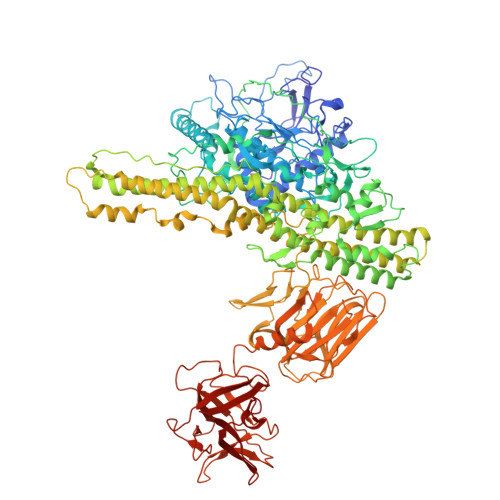Activity of botulinum neurotoxin X and its structure when shielded by a non-toxic non-hemagglutinin protein.
Martinez-Carranza, M., Skerlova, J., Lee, P.G., Zhang, J., Krc, A., Sirohiwal, A., Burgin, D., Elliott, M., Philippe, J., Donald, S., Hornby, F., Henriksson, L., Masuyer, G., Kaila, V.R.I., Beard, M., Dong, M., Stenmark, P.(2024) Commun Chem 7: 179-179
- PubMed: 39138288
- DOI: https://doi.org/10.1038/s42004-024-01262-8
- Primary Citation of Related Structures:
8BYP, 8QFT - PubMed Abstract:
Botulinum neurotoxins (BoNTs) are the most potent toxins known and are used to treat an increasing number of medical disorders. All BoNTs are naturally co-expressed with a protective partner protein (NTNH) with which they form a 300 kDa complex, to resist acidic and proteolytic attack from the digestive tract. We have previously identified a new botulinum neurotoxin serotype, BoNT/X, that has unique and therapeutically attractive properties. We present the cryo-EM structure of the BoNT/X-NTNH/X complex and the crystal structure of the isolated NTNH protein. Unexpectedly, the BoNT/X complex is stable and protease-resistant at both neutral and acidic pH and disassembles only in alkaline conditions. Using the stabilizing effect of NTNH, we isolated BoNT/X and showed that it has very low potency both in vitro and in vivo. Given the high catalytic activity and translocation efficacy of BoNT/X, low activity of the full toxin is likely due to the receptor-binding domain, which presents very weak ganglioside binding and exposed hydrophobic surfaces.
- Department of Biochemistry and Biophysics, Stockholm University, Stockholm, Sweden.
Organizational Affiliation:
















